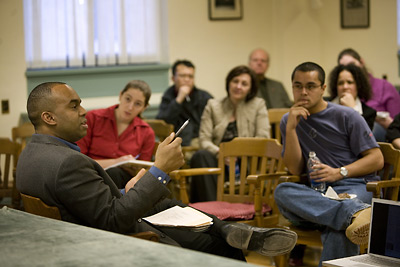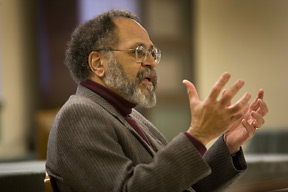At first diversity forum, participants review a Web site aimed at promoting inclusiveness
By Nancy Doolittle


"Last year, the contrast between what we were doing as an institution and what people thought we were doing became clear, and we realized that we needed to foster greater communication, " said David Harris, Cornell vice provost for social sciences, at a gathering attended by about 40 faculty, staff and students in Warren Hall Feb. 8.
Harris was speaking about Cornell's hopes and goals for diversity at the first campus forum held by the new University Diversity Council (UDC). The forum, the first of others to be held by UDC, brought people from across campus together to discuss issues, contribute ideas and to network.
The specific purpose of the forum was to review the new university diversity Web site and offer feedback for future enhancements. The site, http://www.cornell.edu/diversity/, which went live Feb. 1, was spearheaded by the UDC to draw together all the diversity-related events, programs, policies and initiatives on Cornell's Ithaca campus.
Although few students attended the Warren Hall presentation, Harris, who co-chairs the UDC's working group, noted that students will be more likely to attend future forums at such locations as the Cook or Becker houses. He asked for input on what topics the future forums should address.
The Web site is organized around two principles: That a visitor should not have to know Cornell's organizational structure to find out what is going on, and that it is more important to address diversity as a university strategy, rather than as public relations.
"In presenting data about various aspects of inclusiveness and diversity, we will not shy away from showing where Cornell might be lacking as well as where it is doing well," Harris said. "The current site is designed to let you know what we are doing, how we are doing and how you can get involved."
Questions and observations from the audience ranged from basic ("Could you ensure that there is minority alumni representation on the site?") to the complex ("Are we running the risk, in moving from the concept of racial and ethnic diversity toward the concept of inclusiveness, of making it hard for people from different racial or ethnic backgrounds to find themselves in the site?").
In responding to the latter question, Robert L. Harris Jr., Cornell vice provost for diversity and faculty development and co-chair of the UDC working group, pointed out that Cornell's traditional diversity focus was on recruitment numbers -- how many of each group were coming to the university -- with less focus on "what happens once they get here." Recent university studies show that the university needs to foster a climate of inclusiveness for people of all backgrounds, a culture of "interactional diversity," that embraces rather than tolerates diversity and addresses issues specific to particular groups, Robert Harris noted.
But, he said, "We're beginning to think of ways that we can encourage different groups of students to cooperate together across differences in a way that they can learn more from each other."
David Harris voiced his hope that Cornell would be a place to provide opportunities where people can "go across the gaps."
"Our e-mail address is on the site, at diversityinput@cornell.edu. Just shoot us a note," he said. And for those interested in specific aspects of diversity, the Web site will, in the future, be searchable by topic.
Media Contact
Get Cornell news delivered right to your inbox.
Subscribe